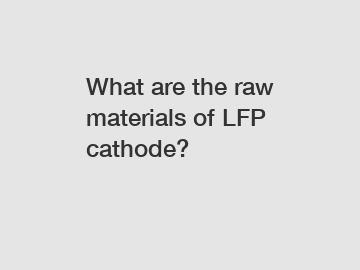What are the raw materials of LFP cathode?
The raw materials of LFP cathode include lithium carbonate, iron phosphate, and carbon additives. These components form the basic structure of the cathode material and play a critical role in determining the performance and characteristics of LFP batteries.
Lithium carbonate is the primary lithium source for LFP cathode production. It is obtained from lithium-rich minerals such as spodumene or lithium brine through a series of chemical processes. Lithium is a key component of the cathode material as it provides the necessary electrochemical properties for energy storage and release.
Iron phosphate, on the other hand, serves as the active material in the LFP cathode. It is commonly derived from natural sources such as iron ore or recycled from various industrial processes. Iron phosphate has a unique crystal structure that allows for efficient lithium ion intercalation and deintercalation during charging and discharging cycles. This property enables LFP batteries to deliver high energy density and maintain stable performance over a long lifespan.

In addition to lithium carbonate and iron phosphate, carbon additives are also incorporated into the LFP cathode. These additives, typically in the form of carbon black or graphene, enhance the electrical conductivity of the cathode material and facilitate the movement of lithium ions between the cathode and anode. This results in improved overall battery performance, including faster charging/discharging rates and higher power output.
The choice of raw materials for the LFP cathode is crucial in determining the overall performance, cost-effectiveness, and environmental impact of LFP batteries. By utilizing lithium carbonate as the lithium source, LFP cathodes can be produced at a relatively low cost compared to other lithium-ion battery chemistries. The abundance of iron and carbon-based materials further contributes to the sustainability and scalability of LFP battery production.
Furthermore, the inherent stability and thermal safety of LFP cathodes make them an ideal choice for applications that require high reliability and safety standards, such as electric vehicles and energy storage systems. LFP batteries have demonstrated excellent thermal stability, resistance to overcharging, and reduced risk of thermal runaway events, making them less prone to safety concerns compared to alternative battery chemistries.
In conclusion, the raw materials of LFP cathode, including lithium carbonate, iron phosphate, and carbon additives, form the foundation of LFP batteries. Through careful selection and optimization of these materials, LFP batteries can deliver high performance, cost-effectiveness, and safety in various applications. The continuous research and development in LFP cathode materials hold great promise for the ongoing advancements in the field of lithium-ion battery technology.
Contact us to discuss your requirements of Polyimide Monomer, 3,3',4,4'-Biphenyltetracarboxylic dianhydride, polyimide monomer supplier. Our experienced sales team can help you identify the options that best suit your needs.
156
0
0


Comments
All Comments (0)